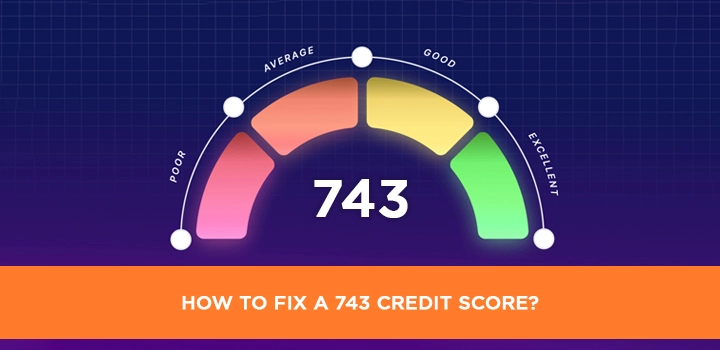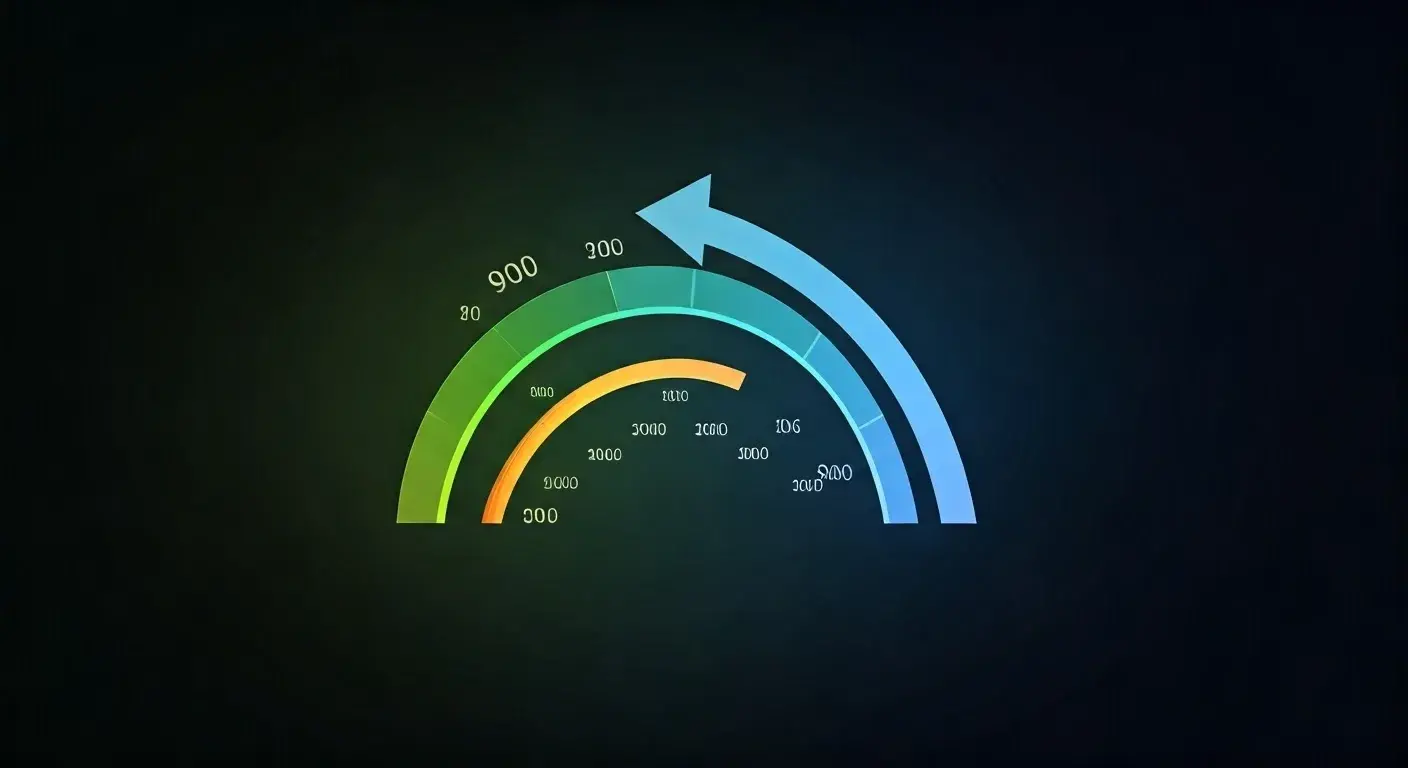-
Posted on: 11 Sep 2023

-
A 743 credit score is a good score, but there's always room for improvement to unlock better loan terms and financial opportunities. This guide will show you precisely how to fix and elevate your 743 credit score, offering actionable strategies and insights for 2025.
Understanding Your 743 Credit Score
A 743 credit score generally falls into the "good" to "very good" range, depending on the specific credit scoring model used (e.g., FICO or VantageScore). In 2025, a score of 743 typically means lenders see you as a relatively low-risk borrower. You're likely to qualify for loans and credit cards, often with competitive interest rates. However, it's not quite in the "excellent" tier (usually 800+), which commands the absolute best terms. Understanding where you stand is the first step towards strategic improvement. A 743 score suggests that while you've managed your credit responsibly for the most part, there might be minor areas where a few adjustments could significantly boost your standing. This score indicates a solid foundation, but also highlights opportunities to refine your credit management for maximum financial benefit.
Key Factors Influencing a 743 Credit Score
Several core components contribute to your credit score. For a 743, these factors are likely balanced reasonably well, but understanding their weight is crucial for targeted improvement.
Payment History (Approximately 35% of Score)
This is the most significant factor. Late payments, missed payments, defaults, bankruptcies, and collections all severely damage your score. A 743 suggests you have a generally strong payment history, but perhaps a few minor blemishes or a lack of a long, consistent record of on-time payments.
Amounts Owed (Credit Utilization Ratio - Approximately 30% of Score)
This measures how much of your available credit you're using. High credit utilization (using a large percentage of your credit limits) signals to lenders that you might be overextended. A 743 score indicates your utilization is likely moderate, but reducing it further can provide a substantial boost.
Length of Credit History (Approximately 15% of Score)
This considers the age of your oldest account, the age of your newest account, and the average age of all your accounts. A longer credit history generally benefits your score, showing lenders a longer track record of responsible credit management. A 743 might reflect a shorter credit history or a mix of older and newer accounts that haven't averaged out to a very long duration yet.
Credit Mix (Approximately 10% of Score)
This refers to the variety of credit accounts you have, such as credit cards, installment loans (like mortgages or auto loans), and retail accounts. Having a mix can demonstrate you can manage different types of credit responsibly. A 743 score might mean you have a limited credit mix.
New Credit (Approximately 10% of Score)
This factor looks at how many new accounts you've opened recently and how many hard inquiries you've had. Opening too many accounts or having too many inquiries in a short period can negatively impact your score, as it may suggest financial distress. A 743 score suggests you haven't recently engaged in excessive new credit applications.
Actionable Strategies to Elevate Your 743 Credit Score
Improving from a 743 credit score requires a focused approach. The goal is to move into the "excellent" range (800+), which can unlock the most favorable financial products and terms. Here are the most effective strategies for 2025.
1. Optimize Your Credit Utilization Ratio
This is often the quickest way to see a score increase. Aim to keep your credit utilization below 30%, and ideally below 10%, on each card and across all your cards combined.
Calculate Your Current Utilization
To do this, sum up the balances on all your credit cards and divide by the total credit limit across all those cards. For example, if you have two cards: Card A with a $5,000 limit and a $1,000 balance, and Card B with a $10,000 limit and a $2,000 balance.
Total Balance = $1,000 + $2,000 = $3,000
Total Credit Limit = $5,000 + $10,000 = $15,000
Overall Utilization = ($3,000 / $15,000) * 100 = 20%
While 20% is good, aiming for below 10% would be even better for a significant score boost.
Strategies for Lowering Utilization
- Pay Down Balances: The most direct method is to pay down your credit card balances. Focus on cards with the highest utilization first.
- Request a Credit Limit Increase: If you have a good payment history with a particular card issuer, you can request a credit limit increase. This increases your available credit without you spending more, thus lowering your utilization ratio. Be aware that this may result in a hard inquiry, which can slightly and temporarily lower your score.
- Spread Balances Across Cards: If possible, strategically pay down one card to zero and use another, or move balances to a card with a higher limit. However, be cautious of balance transfer fees and interest rates.
- Make Multiple Payments Per Month: Pay your balance down before your statement closing date. The balance reported to credit bureaus is typically the one on your statement. Making a payment before the statement closes can reduce the reported balance.
Mastering Credit Utilization Ratio
Credit utilization is a dynamic metric. Lenders and scoring models look at your balances at specific points in time, usually when your credit card issuer reports to the credit bureaus. This typically happens once a month, around your statement closing date. Therefore, managing your spending and payment timing around this reporting date is crucial.
For instance, if your statement closes on the 20th of the month and your credit card company reports that balance to the bureaus, paying down your balance significantly before the 20th will result in a lower utilization being reported. This can lead to a faster score increase than simply paying off the entire balance after the statement due date.
2025 Insight: Many credit scoring models are becoming more sophisticated, but the general principle of low utilization remains paramount. Some newer models may consider average daily balances, making consistent low spending more impactful.
Perfecting Your Payment History
While a 743 score suggests you're not missing payments regularly, even a single late payment can have a significant negative impact. The goal is to establish a flawless record.
Strategies for Impeccable Payments
- Set Up Automatic Payments: Enroll in auto-pay for at least the minimum payment on all your credit accounts. This is a foolproof way to avoid missing due dates. Ensure you have sufficient funds in your bank account to cover these payments.
- Use Calendar Reminders: If you prefer not to use auto-pay, set up calendar alerts a few days before each payment is due.
- Pay More Than the Minimum: Always aim to pay more than the minimum due, and ideally, pay the full statement balance to avoid interest charges. This also contributes positively to your credit utilization.
- Address Past Due Accounts Immediately: If you find yourself with a past-due account, pay it off as soon as possible. While the late payment will remain on your report for several years, bringing the account current stops further damage and shows lenders you're taking responsibility.
Addressing Errors on Your Credit Report
Mistakes on your credit report can unfairly drag down your score. Regularly reviewing your credit reports from all three major bureaus (Equifax, Experian, and TransUnion) is essential. You are entitled to a free credit report from each bureau annually at AnnualCreditReport.com.
Steps to Dispute Errors:
- Identify the Error: Carefully examine your reports for inaccuracies, such as incorrect personal information, accounts you don't recognize, or incorrect payment statuses.
- Gather Evidence: Collect any documentation that supports your claim (e.g., statements showing a payment was made on time, proof of identity, etc.).
- Submit a Dispute: Contact the credit bureau that shows the error. You can usually do this online, by mail, or by phone. You'll need to provide details about the error and your evidence.
- Follow Up: The credit bureaus have a legal obligation to investigate your dispute within a reasonable timeframe (typically 30-45 days). If the error is confirmed, they must correct it.
2025 Update: Credit bureaus are increasingly using digital tools for dispute resolution, making the process potentially faster. However, thorough documentation remains key.
Leveraging Credit Age and Mix
While you can't magically age your credit history, you can influence its average age and diversify your credit mix over time.
Strategies for Credit Age and Mix
- Keep Old Accounts Open: Even if you don't use an old credit card often, keeping it open (especially if it has no annual fee) helps maintain your average age of accounts. If you're concerned about inactivity, use it for a small, recurring purchase (like a streaming service) and pay it off immediately each month.
- Avoid Closing Unused Accounts Carelessly: Closing an account reduces your total available credit, which can increase your credit utilization ratio. It also removes the positive payment history of that account from your report sooner.
- Consider a Credit-Builder Loan: If you have limited credit history, a credit-builder loan from a credit union or bank can help. You make payments on the loan, and the funds are typically held in an account until the loan is repaid. This demonstrates responsible installment loan behavior.
- Explore Secured Credit Cards: A secured credit card requires a cash deposit that usually equals your credit limit. This is an excellent tool for building or rebuilding credit, as it functions like a regular credit card but with reduced risk for the issuer.
Understanding the Impact of Credit Age and Mix
The length of your credit history demonstrates to lenders your ability to manage credit over an extended period. A longer history generally indicates more stability and reliability. Similarly, managing a variety of credit types (revolving credit like credit cards, and installment loans like mortgages or auto loans) shows you can handle different financial obligations.
For a 743 score, focusing on these aspects might involve:
- Patience: Time is the primary factor in increasing the average age of your accounts.
- Strategic Acquisition: If you need to diversify your credit mix, consider adding an installment loan or a different type of credit card after careful consideration of your financial needs and ability to manage it responsibly. Avoid opening accounts solely for the sake of mix if you don't need them.
Strategic Approach to New Credit Applications
Opening new credit accounts can impact your score, both positively and negatively. A 743 score suggests you've been judicious, but it's important to maintain this strategy.
Managing Hard Inquiries
When you apply for credit, lenders often perform a "hard inquiry" on your credit report. Too many hard inquiries in a short period can lower your score by a few points, as it may signal to lenders that you are seeking a lot of credit, potentially due to financial hardship.
- Space Out Applications: Avoid applying for multiple credit cards or loans within a short timeframe. It's generally advisable to wait at least 6-12 months between significant credit applications.
- Understand Rate Shopping: For certain types of loans (like mortgages or auto loans), credit bureaus often allow you to "rate shop" within a specific window (usually 14-45 days, depending on the scoring model) without it negatively impacting your score as much as multiple unrelated inquiries. This is because they understand consumers shop for the best rates.
- Distinguish Hard vs. Soft Inquiries: "Soft inquiries" (like checking your own credit score or pre-qualification offers) do not affect your credit score. Only applications for new credit trigger hard inquiries.
When to Consider New Credit
While it's important to be strategic, there are times when opening a new account can be beneficial:
- To Improve Utilization: If your utilization is high on existing cards, a new card with a higher credit limit can lower your overall utilization, provided you don't carry balances on the new card.
- To Build Credit Mix: If you have a very limited credit mix, a new installment loan or a different type of credit card could be beneficial, but only if you can manage it responsibly.
- For Specific Rewards/Benefits: If you find a credit card with rewards or benefits that align perfectly with your spending habits and you can manage it responsibly, it might be worth considering.
2025 Data Point: Credit scoring models are becoming more nuanced. While multiple inquiries still have some impact, the emphasis is increasingly on responsible credit behavior over the long term. However, it's still wise to be conservative with new applications.
Cultivating Long-Term Credit Health
Building and maintaining an excellent credit score is a marathon, not a sprint. Consistent, responsible financial habits are key.
Key Habits for Sustained Improvement
- Budgeting and Financial Planning: Understand your income and expenses. A solid budget helps prevent overspending and ensures you can meet your financial obligations.
- Emergency Fund: Having an emergency fund can prevent you from relying on credit cards for unexpected expenses, thus protecting your credit utilization and payment history. Aim for 3-6 months of living expenses.
- Regularly Monitor Your Credit: Beyond just checking your score, review your credit reports at least annually for accuracy and to stay informed about your credit activity.
- Educate Yourself: Stay informed about credit scoring models and best practices. Resources from reputable financial institutions and consumer protection agencies are invaluable.
- Seek Professional Advice When Needed: If you're struggling with debt or complex credit issues, consider consulting a non-profit credit counseling agency.
The Benefits of an Excellent Credit Score
Pushing your 743 score into the excellent range (800+) unlocks significant financial advantages:
- Lower Interest Rates: This is the most significant benefit. You'll qualify for the lowest interest rates on mortgages, auto loans, personal loans, and credit cards, saving you thousands of dollars over the life of the loan.
- Better Loan Terms: Lenders are more likely to approve larger loan amounts and offer more flexible repayment terms to individuals with excellent credit.
- Easier Approval for Rentals and Utilities: Landlords and utility companies often check credit scores. An excellent score can make it easier to rent an apartment or get utilities connected without a security deposit.
- Lower Insurance Premiums: In many states, insurance companies use credit-based insurance scores to help determine premiums for auto and homeowners insurance.
- Access to Premium Credit Cards: Excellent credit opens doors to high-reward credit cards with premium benefits like travel points, cash back, and exclusive perks.
2025 Financial Landscape: With interest rates fluctuating and economic uncertainties, a strong credit score is more valuable than ever. It provides a buffer against rising costs and offers greater financial flexibility.
Conclusion: Your Path to an Excellent Credit Score
Achieving an excellent credit score from a solid 743 is well within reach with a strategic and consistent approach. By focusing on optimizing your credit utilization ratio, ensuring impeccable payment history, carefully managing new credit applications, and patiently allowing your credit history to age, you can systematically climb into the 800+ range. Remember to regularly review your credit reports for accuracy and to leverage the power of responsible financial habits. The rewards of an excellent credit score—lower borrowing costs, better loan terms, and greater financial freedom—are substantial and well worth the effort. Start implementing these actionable steps today to secure your financial future.
Faq
Q: How long does it take to improve a 743 credit score?
Improving your credit score is a gradual process. With consistent effort, you may see noticeable improvements within a few months, but it can take a year or more to achieve significant changes.
Q: Can I fix my credit score on my own, or should I hire a credit repair agency?
While you can repair your credit on your own, some individuals opt to hire credit repair agencies for assistance. It ultimately depends on your comfort level and the complexity of your credit issues.
Q: Will closing a credit card account help or hurt my credit score?
Closing a credit card account can affect your credit utilization and average account age. In some cases, it may hurt your score. Consider the implications carefully before closing an account.
Q: What's the quickest way to boost my credit score?
The quickest way to boost your credit score is by paying down high credit card balances and ensuring all bills are paid on time.
Q: Are there any shortcuts to improving my credit score?
There are no quick fixes or shortcuts to improving your credit score. It requires consistent, responsible financial behavior over time.
Q: Can a low credit score be improved to an excellent score?
Yes, it's possible to improve a low credit score to an excellent one with patience, responsible financial habits, and a well-executed credit repair plan.











